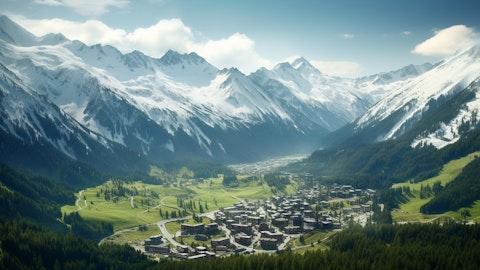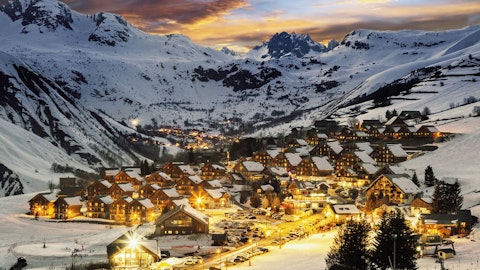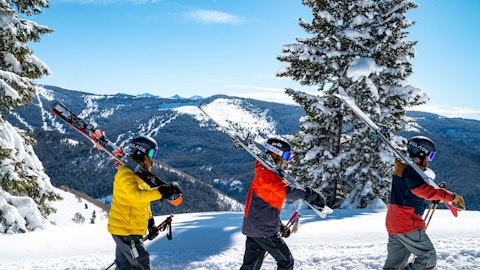Patrick Scholes: Okay. Then my next question – okay. My next question is on this recent A-Basin sale. Was that something you looked at? Or were you concerned about antitrust issues with that? Thank you.
Kirsten Lynch: Thanks. Yes, we obviously had a very long-term relationship with A-Basin over 20 years of a partnership and saw that Alterra made the announcement of an acquisition there. Way back in the 1990s when we acquired Keystone and Breckenridge, we actually divested Arapahoe Basin and then transitioned into a partnership, which we had very successfully for over 20 years. And it makes a lot of sense to us that Alterra appears to be pursuing a strategy that might be more similar to our strategy of an owned and operated model. And we have a lot of respect for Arapahoe Basin and hope it is very successful for them.
Operator: Our next question comes from Megan Alexander, Morgan Stanley.
Louise Doss: Hi. This is Louise Doss on for Megan. Thanks for taking our question. We wanted to start by asking a follow-up to some of the earlier questions on visitation. It’s encouraging that you’ve already seen an improvement quarter-to-date based on your commentary, but it also seems like you are expecting further improvement here in March and then April. So we were hoping that you could maybe quantify some of what is embedded as it relates to visitation and the updated guide for 3Q? And are you expecting kind of similar improvement that you saw in February or perhaps more given the spring break and early Easter dynamics?
Angela Korch: Hi. Thanks for the question. Yes, we’ve said about our rest of year guidance, right, as we’ve been looking at kind of as the trends have progressed through the season-to-date period and then we’re looking at our guest behavior to say why do we think that implies. And we have a significant base of pre-committed guests that we understand their behavior. And so we are assuming that we’ll have a shift in visitation patterns in the March and April from both that and also just right what we mentioned before in terms of conditions and lodging bookings and that is in the visitation rest of your assumptions. Obviously, that translates into revenue guidance for the rest of the year as well.
Kirsten Lynch: Another way to think about it is the expectation that those – that our guests in spring, given the conditions are in a much better place would return to more typical historical behavior.
Louise Doss: Okay. Great. Thank you so much. And I understand that you aren’t going to guide for 2025 at this point. But one of the questions we are getting is how to think about how much of the reduction in the guide is related to abnormal weather and thus perhaps that you could get back next year? Would it be possible to maybe just quantify how much of the 2Q underperformance was related to weather?
Kirsten Lynch: I think on a full-year fiscal year basis, we’ll be able to provide more context when we get through the season if we’re heading into next fiscal year because so much of this is seeing what the behavior changes are as we go through. And there’s still a substantial part of the season left for us. So you can expect that we’ll provide more details and commentary on that later in our fiscal year.
Operator: Our next question comes from Chris Woronka, Deutsche Bank.
Chris Woronka: Hey. Good afternoon everyone. Thanks for taking our questions. I wanted to ask a little bit about the ancillary, right? And maybe we could drill down and just kind of get a sense for some of the growth items that held up a lot better than your skier visits. Can you maybe give us a sense for what’s pricing versus what’s transactional? Any kind of way to slice and dice the way people are using ancillary versus how much of it is coming from price? Thanks.
Kirsten Lynch: Yes. I’ll let Angela weigh in with her perspective and additional thoughts on this as well. But I think the easiest way to think about it is a combination very – based on the line of business on capture, what the capture of our guests was to spend per guest or per visit and also the pricing increase that was taken on each line of business. And it varies by business, but generally a combination of those factors. Angela, did you have any other comments that you wanted to make on it?
Angela Korch: Yes. Just building on that, of course, we look – we do look and see across all of our lines of business that we generally take price above inflation there. So there is a pricing component that you’ll see, and we do that dynamically depending on where we’re seeing also peak demand periods or by line of business. And this year, in particular, we talked about some of our specific initiatives around F&B, in particular, returning getting captured back and really how to awareness campaigns and other initiatives to drive F&B. And then you saw on ski school, right, up 5.5% on revenue growth, which was obviously much higher than the visitation trend, which shows that we continue to have success driving both volume and capture across that line business as well.
Chris Woronka: Okay. I appreciate that. And then the second – the follow-up question is really related to lodging. And I know you called out having fewer units to rent through the rental program. Can you tell us – is that more of a structural issue? Is that something that going forward? Or is that just going to vary year to year in terms of how many you have available?
Kirsten Lynch: Yes. That does vary from year to year. It can depend on a lot of things, both in terms of which properties we have in our property management pools. Also can depend on owners’ desire to take units on and off the market, depending kind of on their own needs. So that will just vary based on trends each year that we’re seeing.
Operator: Our next question comes from Brandt Montour from Barclays.
Brandt Montour: Good evening everybody. Thanks for taking my question. So during COVID, you guys cut the price of the pass meaningfully, right? And units grew 50% and now it seems like you’re seeing some folks not use the pass to some certain extent. And I guess the question is, are you concerned at all over elevated churn from either pricing elasticity with the price hike or from people going back to work and not having as many days to travel post this revenge travel sort of normalization phase that we’re all going through. What are your thoughts on that?
Kirsten Lynch: That’s correct, Brandt. We took a 20% price reset in FY2022 based on price elasticity data and the goal to move a much greater percentage of our visits committed in advance for this exact reason that trying to create stability because of the weather variability that impacts the ski industry, and we were quite successful in doing that. Then took another, then took 7% in group passes again, 8% and group passes again last year. Pass utilization, whether that’s frequency or the timing of when a guest uses their pass, varies every year. We have a lot of data and information on it, and we have a lot of data on how that’s predicted to their renewal rate. And even with the weather variability that we’ve had, as you might recall from December when we finished our pass sales, our renewal was a huge driver of the growth, which is the loyalty to our pass program.
So as we think about this year, this year and their utilization is greatly impacted by I don’t think I can emphasize enough, snowfall being down 42% is a significant impact on the ski industry. And so the really the belief is that our pass holders, based on their historical behavior should return to a normal typical utilization. And then the price increase that we’re taking for next year is based on the data that we have about our price elasticities and what we believe is the right approach to our pricing going forward. And just as a reminder, when we took the price reset, we did say and we have consistently executed on that we believed that there were still – were still price increases we could take from the reset, and we’ve consistently delivered on that.
Brandt Montour: Okay. That’s super helpful. And then a follow-up, sort of a different question or same question, different flavor. You guys have a lot of data, right? And then you have past data for 12 or 14 years. And so can you look back at times when you had two years in a row of poor weather or even one year. I mean, last year, we had you had poor weather and you had great pass sales the next year. And I’m curious if there’s any correlation either positive or negative, of how pass sales go for a year following a year with bad weather. Are you most more likely to see elevated churn? Or are you more likely to see pent-up demand?
Kirsten Lynch: Yes. You’re absolutely right, Brandt. We have a lot of pass data and really years and years and years of data even understanding when someone doesn’t use their pass a single day what their renewal rate looks like. And so we can get highly predictive and pretty accurate in terms of pass renewal going into the following season because we have so much data on that. And we, of course, being in the ski business have had many years where we’ve had weather challenges and disruptions so that we can see that. That is that data will be factored into the forecast that we have for our pass sales going into FY2025 and the data about what we expect in spring of this year and utilization by our pass holders based on their historical behavior is factored into the guidance that we just published as well.
Operator: This concludes the Q&A portion of today’s call. I would now like to turn the call back over to Kirsten Lynch for closing remarks.
Kirsten Lynch: Thank you, operator. This concludes our fiscal 2024 second quarter earnings call. Thanks to everyone who joined us today. Please feel free to contact me or Angela directly, should you have any further questions. Thank you for your time this afternoon. Goodbye.
Operator: This concludes today’s Vail Resorts fiscal second quarter 2024 earnings call and webcast. You may disconnect your line at this time, and have a wonderful day.



